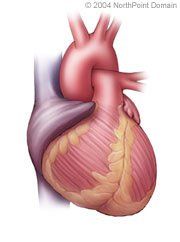Congenital Heart Disease
Basic Facts
- Congenital heart disease is a heart defect that is present from birth.
- Congenital heart disease includes malformations of blood vessels in the heart, problems with heart valves, structural defects of the heart muscle walls, and abnormal connections between the heart and the blood vessels that carry blood to and from the heart.
- Congenital heart disease can cause problems in children immediately after they are born, although other defects heal in childhood. Still other defects can become more abnormal with age and can cause symptoms and problems in adulthood.
Congenital heart disease refers to heart defects that have been present since birth, which include:
- Abnormally shaped blood vessels;
- Missing or defective valves;
- Abnormal connections between the heart and the main arteries and veins; and/or
- Defects of the walls that separate the chambers of the heart.
Congenital heart defects include:
- Atrial and ventricular septal defects;
- Coarctation of the aorta;
- Aortic, mitral, pulmonic, and tricuspid valve defects; and
- Tetralogy of Fallot.

WHAT ARE THE SYMPTOMS?
Symptoms vary, depending on the defect.
Septal defects
In childhood, there may be few, if any, symptoms. Teens and adults may experience the following:
- Palpitations;
- Fatigue;
- Shortness of breath; and
- Heart murmur.
Coarctation of the aorta
Symptoms may include:
- Dizziness;
- Fainting;
- Nosebleeds;
- Headaches;
- Cold feet or legs;
- Leg cramps while exercising;
- Localized hypertension; and
- Low stamina.
Aortic valve defects
People with aortic stenosis, or narrowing, may not experience any symptoms until they develop congestive heart failure. Those with aortic regurgitation, a type of valve defect, may experience the following:
- Palpitations;
- Chest pain; and
- Night sweats.
Mitral valve defects
People with mitral valve defects may not display symptoms until their 30s, when they may experience:
- Fatigue;
- Weakness;
- Ankle swelling;
- Congestion;
- Shortness of breath while lying down or after exercise;
- Palpitations;
- Chest discomfort;
- Lightheadedness;
- Loss of consciousness; and
- Symptoms of heart failure.
Pulmonic valve defects
When pulmonic stenosis is severe, people may experience:
- Shortness of breath while exercising;
- Fatigue;
- Swelling in the arms, legs, and abdomen;
- Audible heart murmur; and
- Cyanosis.
Tricuspid valve defects
The symptoms of tricuspid stenosis include:
- Upper right abdomen discomfort;
- Fatigue;
- Weakness;
- Shortness of breath;
- Fluid retention;
- Nausea;
- Vomiting; and
- Cyanosis.
Those with tricuspid regurgitation may also have an enlarged liver.
Tetralogy of Fallot
Symptoms that may indicate tetralogy of Fallot include:
- Cyanosis;
- Anxiety;
- Breathing difficulties;
- Loss of consciousness after activity;
- Bulging nail beds; and
- Symptoms of congestive heart failure.
CAUSES AND RISK FACTORS
The exact cause of congenital heart defects is largely unknown, but many experts believe that genetic and environmental factors play a role.
Risk factors that can increase the chances that an infant will be born with congenital heart disease include:
- Excessive alcohol consumption by a pregnant woman;
- Certain infections occurring during pregnancy, such as rubella.
DIAGNOSIS
A physician diagnoses congenital heart disease by evaluating the person's medical history and symptoms, and by using a variety of tests, which include:
- Blood count and hematocrit;
- Cardiac catheterization;
- Chest x ray;
- Computed Tomography (CT) scan;
- Duplex ultrasound;
- Echocardiography;
- Electrocardiography; and
- Magnetic resonance imaging (MRI).
TREATMENT APPROACH
Many people are treated with medications. Some of the most commonly prescribed medication groups are:
- Diuretics;
- Beta-blockers;
- Digitalis drugs;
- Anticoagulants; and
- Angiotensin converting enzyme (ACE) inhibitors.
Surgery
Surgery can correct most congenital heart defects. A procedure is performed while the patient is under general anesthesia and usually lasts 2 to 5 hours. Most procedures require open-heart surgery, although some repairs can be made with a catheter.
Septal defects
If the hole in the septum is small, it can be closed using a special thread made of a polymer material. For larger defects, the surgeon will use a synthetic fabric patch or the patient's own pericardium, or pericardium from a cow or other animal.
Some atrial septal defects can be corrected using a synthetic patch.
Coarctation of the aorta
Surgical correction includes removing the narrowed segment of the aorta and connecting the two ends or by placing a synthetic graft.
Valvular defects
Heart valves can either be repaired or replaced with a tissue or mechanical valve.
Tetralogy of Fallot
Surgery to widen the pulmonary valve and correct ventricular septal defect is usually recommended to treat tetralogy of Fallot.
Copyright © 2017 NorthPoint Domain, Inc. All rights reserved.
This material cannot be reproduced in digital or printed form without the express consent of NorthPoint Domain, Inc. Unauthorized copying or distribution of NorthPoint Domain's Content is an infringement of the copyright holder's rights.
